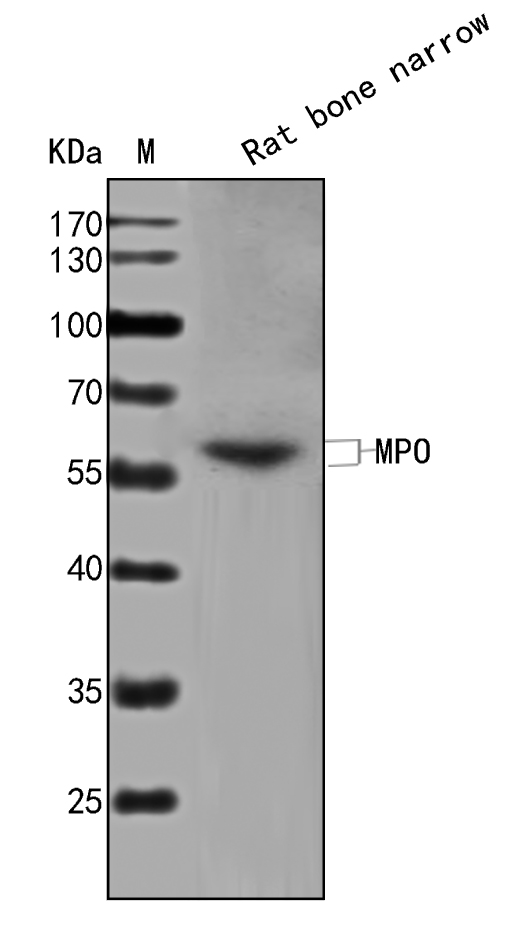
Anti-MPO Antibody, Mouse Monoclonal, A8T
产品编号:MA00648HuM10-A8T
$ 询价
规格 100ul
产品名称:Anti-MPO Antibody, Mouse Monoclonal, A8T
克隆号:A8T
抗体亚型:/
经验证的应用:/
交叉反应:Predict reacts with: Human/Mouse/Rat
特异性:/
免疫原:Recombinant human MPO protein
制备方法:Produced in mouse immunized with MPO, and purified by antigen affinity chromatography.
来源:Monoclonal Mouse IgG
纯化:Immunogen affinity purified
缓冲液:Supplied in PBS, 50% glycerol and less than 0.02% sodium azide, PH7.4
偶联物:Unconjugated
浓度:Liquid
运输方式:This antibody is shipped as liquid solution at ambient temperature. Upon receipt, store it immediately at the temperature recommended.
储存条件:This antibody can be stored at 2℃-8℃ for one month without detectable loss of activity. Antibody products are stable for twelve months from date of receipt when stored at -20℃ to -80℃. Preservative-Free. Avoid repeated freeze-thaw cycles.
图片:
Figure1.Western blot analysis of extracts of various lane1 rat bone narrow, using MPO antibody (MA00648HuM10-A8T) at 3ug/ml Secondary antibody: HRP Goat Anti-Rabbit IgG (H+L) at 1:20000 dilution. Lysates/proteins: 25ug per lane.Blocking buffer: 3% nonfat dry milk in TBST. Detection: ECL Basic Kit . Exposure time: 20sec.
Figure2.Immunohistochemistry (Formalin/PFA-fixed paraffin-embedded sections) analysis of monkey prostate、monkey spleen、monkey testis sections labelling MPO with purified MA00648HuM10-A8T at 10ug/ml dilution . Heat mediated antigen retrieval was performed using Heat mediated antigen retrieval using citrate buffer (PH6.0). Tissue was counterstained with Hematoxylin. Mouse specific IHC polymer detection kit HRP/DAB secondary antibody was used at 1:2000 dilution. PBS instead of the primary antibody was used as the negative control.
别称:MPO, myeloperoxidase
背景信息:Myeloperoxidase/MPO. Myeloperoxidase (MPO) is a heme-containing enzyme belonging to the XPO subfamily of peroxidases. It is an abundant neutrophil and monocyte glycoprotein that catalyzes the hydrogen peroxide-dependent conversion of chloride, bromide, and iodide to multiple reactive species (1). Post-translational processing of MPO involves the insertion of a heme moiety and the proteolytic removal of both a propeptide and a 6 aa internal peptide (2). This results in a disulfide-linked dimer composed of a 60 kDa heavy and 12 kDa light chain that associate into a 150 kDa enzymatically active tetramer. The tetramer contains two heme groups and one disulfide bond between the heavy chains (2). Alternate splicing generates two additional isoforms of MPO, one with a 32 aa insertion in the light chain, and another with a deletion of the signal sequence and part of the propeptide (3). Human and mouse MPO share 87% aa sequence identity. MPO activity results in protein nitrosylation and the formation of 3-chlorotyrosine and dityrosine crosslinks (4‑6). Modification of ApoB100, as well as the lipid and cholesterol components of LDL and HDL, promotes the development of atherosclerosis (5, 7‑9). MPO is also associated with a variety of other diseases (1), and inhibits vasodilation in inflammation by depleting the levels of NO (10). Serum albumin functions as a carrier protein during MPO movement to the basolateral side of epithelial cells (11). MPO is stored in neutrophil azurophilic granules. Upon cellular activation, it is deposited into pathogen-containing phagosomes (2). While mice lacking MPO are impaired in clearing select microbial infections, MPO deficiency in humans does not necessarily result in heightened susceptibility to infections (12, 13).
全称:Myeloperoxidase (MPO)
说明书:待上传


